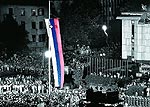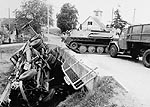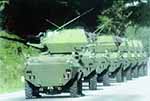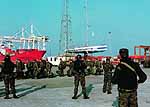
From "Slovenska vojska", an informative professional
military magazine of the Ministry of Defence, special edition, May
2001
 |  |
Burning tanks at the Rozna Dolina border crossing near Nova Gorica.
Photo: Military History Centre Archives |
The confidence of every nation is deeply rooted in a strong desire
to have a full control over its own territory. In the early Middle
Ages the Slovenes had their own states of Carantania and
Carniola. After that, Slovenes were under the heel of foreign rulers
until 1918. After the disintegration of the Austro-Hungarian monarchy,
the first Slovenian state in recent history originated on 29 October
1918. Slovenian nationhood was re-established during the national
liberation war in 1941-1945. In both cases, nationhood was lost within
the construct of Yugoslavia. After World War II, the Slovenian
Republic had all of the elements of a state except independence. As a
consequence, it could not determine its own destiny. However, such a
status could not last forever.
 |  |
The Proclamation of Independence of the Republic of Slovenia, 26 June 1991.
Photo: Bruno Toic |
Factors that led to war
The ten-day war for Slovenia was a consequence of the Slovenian
tendencies towards decentralisation and democratisation. Slovenia's
proposal of a different arrangement of existing relations was
rejected. Pressures towards a Greater Serbia, first in Kosovo and
then, threateningly in other parts of Yugoslavia caused that a large
majority of the Slovene electorate voted for a sovereign, independent
state in the December 1990 referendum. After multi-party elections in
Slovenia in April 1990, the Yugoslav People's Army YPA) began
preparations for an armed response to democratic changes in Slovenia
and Croatia by confiscating the majority of Territorial Defence (TD)
forces' weaponry.
The disintegration of Yugoslavia was greatly enhanced by the
promotion of Greater Serbia with Slobodan Milosevic at its head. The
suppression of those who disagreed had its supporters among even the
highest ranks of the YPA, even though many officers believed for a
long time that preparations to "settle accounts" were aimed
at defending the Yugoslav idea of the equality of all peoples.
Slovenia, on its part, was also preparing for a declaration of
independence by providing reinforcement to the Slovenian TD and police
forces. On 28 September 1990, a constitutional amendment was adopted
which stipulated that in peace and emergencies, the command of TD was
to be transferred to the Presidency of the Republic of Slovenia. The
Presidency, with Milan Kucan as its President at that time and during
the war, immediately appointed a new TD National Command under the
command of Janez Slapar.
On 18 March, as tensions increased, the RS Presidency established a
Contingency Operational Coordination Staff co-chaired by Igor Bavcar
and Janez Jansa. It was tasked with the coordination of security and
defence preparations and in wartime, the tasks of the staff of the
commander-in-chief. The main Slovenian armed components at that time
were the Territorial Defence and police forces. Civil defence forces,
the criminal investigation agency and VIS ?? had the important
mission of protecting human lives and property.
 |  |
The YPA tried to occupy all Slovenian border crossings. However, by 4 July, they were all in Slovenian hands.
Photo: Military History Centre Archives |
Slovenian defence tactics were based on an April 1991 document that
dealt with possible dissolution from a defence perspective. In case of
an armed YPA attack the plan was to block all of the units and
barracks in Slovenia, to stop any advances from Croatia made by the
YPA and to resist actively wherever Slovenian defence forces had the
military advantage. The first location chosen by the YPA to settle
accounts with Slovenia was Maribor, where on 23 May, it provoked an
incident in order to attack a TD training centre. The YPA even
kidnapped the Slovenian negotiator, Lieutenant Colonel Vladimir
Milosevic. In addition, the first Slovenian fatality, Josef Simcik
from Miklavz, was run down and killed by a military APC. The resolute
response of the Centre personnel and the inhabitants of Maribor spoilt
the YPA's plans.
 |  |
Radenci, 28 July 1991
Photo: Natasa Juhnov |
On 25 June 1991, a constitutional law on independence was adopted
by the Slovenian Assembly. Yugoslav signs and flags at border
crossings were replaced with Slovenian ones, and border crossings with
Croatia set up. The evening of the same day, the Federal Executive
Council convened in Belgrade. It issued a decree for the protection of
the national borders in Slovenia, which gave the YPA and federal
police forces the green light for an armed attack on Slovenia.
The approach of the military and police forces was focused in the
first phase on the Slovenian borders and the Brnik airfield. If
Slovenia was cut off from the outside world in the first phase,
"getting even" with those in Slovenia who were in favour of
independence by replacing them with new people who would be puppets in
the implementation of the Serbian goals would follow in the second
phase.
On 26 June, the first armoured units of the Rijeka corps set off
towards the Italian border crossings. On their way, they encountered
poorly-defended barricades and spontaneous, occasionally very
determined resistance on the part of the local population, in
particular in Vrhpolje. Unarmed civilians were not able to stop the
march of the tanks but they reacted decisively against the aggression,
a reaction which later became evident all over Slovenia. Eventually,
this attitude spread all across Slovenia. At 1430, the first shot was
fired in Divaca by a YPA officer, as a threat to the Slovenian
demonstrators.
YPA tactics for border crossings was defined by special orders. At
first step, the YPA was to demand that a border crossing surrender,
then it was to threaten to shoot and finally to fire near the border
crossing and at the centre of the resistance. Based on its experiences
in Kosovo and Croatia, the YPA were brought into the action in
Slovenia under the false assumption that the Slovenes could be
defeated with no major problems. As a result, deployed YPA units had
inadequate logistical support. In addition, critical tactical
principles, such as the fact that tanks cannot survive on a
battlefield without infantry support, were not followed. The units
used in the military intervention in Slovenia were made up of elements
from Ljubljana, Maribor, Rijeka, Zagreb and Varazdin corps and the YPA
Air Force Corps. They were all under the command of the 5th Army
Command in Zagreb. 22,300 YPA and 16,000 TD servicemembers were
stationed in Slovenia. During the war this number increased to 35,200
servicemembers. The Slovenian police force consisted of 10,000 active
and reserve members. The YPA had an absolute advantage in both weapons
and powerful armoured units with air support. The Slovenian military
and police had only infantry weapons, and a few 20 mm anti-aircraft
guns and 82 mm mortars, but no tanks, aeroplanes or
artillery. Portable grenade launchers were used as anti-tank weapons
and portable Strela rockets for air defence against aircraft flying at
low altitudes.
The war begins
Thursday, 27 June
The war for Slovenia started at 0115 when a YPA anti-aircraft
armoured battery crossed the republic border near Metlika. At 0240 the
1st Armoured Battalion set off for Brnik from the Vrhnika barracks.
The column of armoured vehicles that was advancing through Bela
Krajina consisted of 12 armoured combat vehicles with 3-tube
anti-aircraft 20 mm guns and several trucks. They were stopped by a
barricade in Poganci. The tension between the territorial defence
force and YPA soldiers increased and the first shots were fired. At
1030 the column set off toward Ljubljana but was stopped by a road
obstacle near Medvedjek at 1545.
 |  |
Gornja Radgona, 29 June 1991
Photo: Military History Centre Archives |
The armoured battalion was moving from Vrhnika towards Brnik in a
two column formation. On its way, it was stopped by improvised,
poorly-defended automobile barricades. One column was moving along the
highway and the Ljubljana loop bypass via Trzin and Menges, and the
other one along the main road. They took a wrong turn and drove into
the forests around the Tosko celo hilltop and lost two tanks while
they were turning around on the narrow path. The first tanks reached
Brnik around 0500. They took the area around the airport and were
attacked by a TD unit around 1800. After the attack, the tanks took
perimeter defence positions.
In Trzin, the Vrhnika YPA column left behind three armour transport
vehicles and a signal vehicle. Towards the evening members of a
commando detachment were dropped off by two YPA helicopters in support
of armour units. In the approximately 20 minute engagement between the
special police unit and TD, 4 YPA soldiers and 1 TD soldier were
killed. The rest of the YPA soldiers surrendered, and the YPA commando
detachment, which withdrew toward Depala vas, were captured the next
day.
 |  |
Surrender of YPA soldiers
Photo: Military History Centre Archives |
Around 0900, 10 tanks left Maribor and headed to Sentilj. 5 tanks
and 10 armoured vehicles, were also heading for Dravograd. The first
column was stopped by a defensive barricade in Pesnica. Around 1200
the tanks started delivering area fire around the barricade and set it
on fire. Around 1730 the tanks were attacked by TD forces.
On the bridge over the river Drava a tank column commanded by
Colonel Popov was stopped in its attempt to enter Slovenia from
Croatia. An armoured column that entered Slovenia in the vicinity of
Razkrizje was also stopped.
In the evening a YPA column of armoured vehicles tried to break
through near the village of Rigonce but was stopped. At 2045 two 82 mm
mortars were engaged in an attack on the Cerklje airfield, but later
most of the aircraft left the airfield. A YPA column of armoured
vehicles and TD servicemembers got involved in a serious fight in
Koseze, near Ilirska Bistrica, during which three YPA soldiers were
killed. In the evening, two helicopters were shot down, one over Ig
and the other over Ljubljana.
Friday, 28 June
During the night the Slovenian armed forces were reinforcing their
barricades and directing the newly mobilised TD units towards the
occupied border crossings. The following order was issued to all of
the subordinate coordination groups: "At all locations where RS
armed forces have the tactical advantage, offensive actions against
enemy units and facilities will be carried out. The enemy will be
summoned to surrender, the shortest deadline possible for surrender
given and action taken using all available weapons. While in action,
the necessary arrangements will be made to evacuate and protect the
civilians".
 |  |
Regular press conference at Cankarjev dom during the War of Independence
Photo: Borut Kranjc |
The tanks that had spent the night in front of the barricade in
Pesnica managed to remove the barricade by 0700 and continued towards
Sentilj. They were stopped by a barricade in Ranca and two tanks got
stuck in Kaniza. Around 1030 the rest of the tanks were stopped by a
defensive barricade in Strihovec and attacked by TD servicemembers and
the police force. After 1100 the YPA Air Force aeroplanes arrived in
assistance of the tanks, launching rockets and firing on the
barricade. At 1330 four aeroplanes attacked again and killed four
truck drivers. Then the tanks circumvented the obstacle but were soon
stopped. At 0950 the Slovenian units attacked a YPA column of
armoured vehicles at Medvedjek. 6 truck drivers were killed during YPA
air raids.
In Limbus near Maribor two YPA tanks were successfully attacked. In
Gibina, a column of armoured vehicles that was advancing from Croatia
was stopped. A YPA column of armoured vehicles that had advanced from
Maribor was stopped before reaching Dravograd. Following a close
engagement, the Holmec border crossing was taken. Two police officers
and three YPA soldiers were killed and 91 were captured. TD units
attacked the Bukovje barracks near Dravograd and Yugoslav aircraft
attacked the Brnik airport, TV transmitters at Krim, Kum and Nanos,
the Karavanke tunnel, Kocevska Reka and Murska Sobota. The column of
armoured vehicles commanded by Colonel Popov that entered the
Slovenian territory near Razkri3je took the Gornja Radgona border
crossing. Its freight vehicles were set on fire by local volunteers.
When the YPA weapons depot in Borovnica was taken, TD weapons
supplies improved significantly. TD also took a depot in Leskovec, but
failed in its attack on the Ribnica barracks. In Crnice in the Vipava
valley, TD responded to the fire from the YPA column and two soldiers
were killed. A combat group commanded by Major Lisjak attacked and
took the Rozna dolina border crossing. Two tanks were destroyed and
three tanks captured, while three YPA soldiers were killed and 98
captured. The YPA listening post at Roznik pri Ljubljani was taken and
the one at Suha destroyed. The Skofja Loka barracks and the Drulovka
YPA depot were both attacked. Two Austrian journalists were killed by
the YPA at the Brnik airport. At night, a TD servicemember, Peter
Petric, approached the tanks near the airport, fired at the commanding
tank, wounded the commander and was himself killed. At 2100, a
cease-fire was announced by the YPA since the situation was getting
worse for the units who were surrounded.
 |  |
A column of YPA armoured combat vehicles at Medvedjek.
|
Saturday, 29 June
During the night between Friday and Saturday, Slovenian
representatives met with three Ministers of Foreign Affairs from the
European Community and the President of the Federal Executive Council
in Zagreb. They reached an agreement on ceasing hostilities, which was
so unclear that it was never implemented. In the morning, the soldiers
and the federal police officers in the YPA Air Force Base at the Brnik
airport, who were surrounded, surrendered. An NCO fired at the
commander of the YPA fuel depot in Mokronog, who wanted to surrender
and threatened that he would blow up a fuel tanker.
An attack on a YPA APC near Moretini as well as an engagement
between the police officers and YPA soldiers near Skofije were both
success. In Strihovec, a tank column that was advancing towards
Sentilj, was split up. The tanks from this column were later
re-organised into a TD tank company.
The YPA gave written ultimatum to the Presidency and the Government
of the Republic of Slovenia, demanding that Slovenia surrender by 30
July 0900. In the evening, the Slovenian Assembly met and opted for a
peaceful solution to the crisis that did not jeopardise Slovenian
independence.
Sunday, 30 June
At 0900 the air raid alarm sounded, as the YPA aircraft were
heading from the Croatian airfields towards Slovenia. However, they
soon turned around and returned to their bases. In the Varazdin,
Zagreb and Rijeka corps, new forces were being formed in order to
attack Slovenia.
TD forces attacked the platform in front of the Karavanke tunnel,
and at night an agreement was made to hand over the tunnel.
The signal centre above Senozece was taken. The tanks that had been
confiscated near Nova Gorica were organised into a TD company
consisting of nine tanks. Monday, 1 July
At around 0230, a fire and an explosion destroyed the YPA weapons
depot at Crni Vrh near Idrija. TD weaponry had also been stored in the
depot. After a skirmish in which the commander was killed, the YPA
guardhouse at Nova Vas surrendered. The YPA was providing backup and
equipment to the units which were surrounded with helicopters with Red
Cross insignia. The column of armoured vehicles at Medvedjek was given
permission to move to the new barricade in the Krakovski forest by
night.
Evening brought a new YPA ultimatum.
Tuesday, 2 July
The most decisive part of the war for Slovenia began. At 0500 TD
units attacked the column of armoured vehicles in the Krakovski forest
with a decisive blow. The YPA armoured battalion from Jastrebarsko
tried to enter Slovenia to rescue the column in the Krakovski forest,
which had been surrounded at Prilipe, but because of their losses, had
to stop. In this hopeless situation the YPA soldiers left their
vehicles and were captured the following day. At 1330, TD firing of
tank artillery began an attack on the YPA guardhouse at Sentilj. 65
grenades were fired on the positions east of the border crossing and
25 grenades on the guardhouse, which had been abandoned by YPA
soldiers.
At 1615 TD units attacked the YPA armoured units at the Gornja
Radgona border crossing. Tankfire destroyed part of the town. YPA
armoured units were backed up by two airplanes. The YPA storehouse at
Loznica, the Rajhenav logistical point and the warehouses formerly
belonging to TD at Prule in Ljubljana were taken. YPA aircraft
attacked the transmitters on Nanos, Kum and Domzale, and two
barricades, one in Catez and another in Krakovski forest. After a
serious battle in which the commander was killed, the Kuzma guardhouse
surrendered. In Maribor, howitzers fired from the Franc Rozman-Stane
barracks towards Pohorje. After a YPA air raid, TD forces were
attacked again between 1530 and 2130 in front of Dravograd by a column
of armoured vehicles.
Tanks left the Vrhnika barracks and headed for Ljubljana and
Logatec, but were halted at Cesarski vrh and Sinja Gorica. A column of
armoured vehicles at Orehek was attacked and the Fernetici and
Gorjansko border crossings were captured.
At 2100 the RS Presidency agreed to a unilateral cease-fire because
of the collapse of the Belgrade-led military offensive. On the TV
evening news, the Chief of the General Staff Blagoje Adjic threatened:
"We will take control and bring things to an end!"
Wednesday, 3 July 1991
A guard of the armoured-mechanised division set off for Slovenia
from Belgrade. However, because of numerous breakdowns, a growing
number of vehicles were left by the side of the road and the march
collapsed.
In the morning, the TD and police surrounded the YPA soldiers, who
had withdrawn from the Sentilj guardhouse. 2 officers, 3
non-commissioned officers and 45 soldiers surrendered without a
fight. A column of armoured vehicles advancing to Gornja Radgona was
attacked near Videm ob Scavnici, and a YPA column of armoured vehicles
was finally halted near Radenci. This unit had advanced from Croatia
in order to provide support to the unit at the Gornja Radgona border
crossing which was surrounded. Another attack on a column of armoured
vehicles at Kog was successful.
The YPA agreed to a cease-fire. YPA helicopters with Red Cross
insignia continued to bring reinforcements. Slovenia did not respond
because of the cease-fire agreement.
The War is Won
On Thursday, 4 July, all border crossings were in Slovenian hands. YPA
units were withdrawing to Croatia and their barracks. Slovenia
permitted the withdrawal of a tank column from Brnik and a column of
armoured vehicles from Dravograd.
In Maribor, the policeman Robert Hvalc was killed during a YPA
attack on a police vehicle. Permission was given for the YPA column
of armoured vehicles to withdraw from Gornja Radgona, which left
behind ruins and a ravaged border crossing.
 |  |
TD air defence unit at Ljubljana Castle, 2 July 1991
Photo: M.Gerbajs |
On Sunday, 7 July, representatives of Slovenia, the Socialist
Federal Republic of Yugoslavia (SFRY) and the European Community met
on the Brioni islands. The Brioni declaration, which established a
three-month moratorium on Slovenian independence activities was
accepted. However, the Slovenian armed and police forces retained full
sovereignty over Slovenian territory. As a result, the SFRY Presidency
reached a decision on 18 July to withdraw YPA arms and equipment from
Slovenia in three months. The last soldiers left Slovenia from the
port of Koper the night between 25 to 26 October.
According to rough estimates, the YPA had 44 casualties and 146
wounded, and the Slovenian side 19 casualties and 182 wounded. 12
foreign citizens were killed. There is no data available as to the
number of Slovenian soldiers killed while attempting to escape from
the YPA. 4693 YPA servicemembers and 252 federal police officers were
captured. There were 72 minor and major armed conflicts during the
war. 31 YPA tanks, 22 personnel carriers and 6 helicopters were
destroyed, damaged or confiscated, along with 6,787 infantry, 87
artillery and 124 air defence weapons according to YPA inspections.
 |  |
The last YPA soldiers left Slovenia, Koper, 25 October 1991
Photo: Military History Centre Archives |
The victory in the war for Slovenia was a military one. Slovenia's
independence was defended with arms by the Slovenian armed and police
forces, who ensured the success of the political and international
diplomacy needed to conclude the war. Slovenia's strategy and tactics
were the decisive elements. Unlike subsequent events in Croatia and
Bosnia, in Slovenia the aggressor was under threat throughout the
country and was thus unable to concentrate its forces in the areas
most supportive of their initiative. By setting up barricades, the
Slovenian armed forces prevented YPA units from conducting
manoeuvres. It also carried out decisive attacks in areas where there
was tactical advantage. The final defeat of the YPA in Slovenia and
the destruction or capture of its units was, therefore, only a matter
of time.
Brigadier Janez J. Svajncer
References:
Vojna za Slovenijo, Cankarjeva zalozba, Ljubljana 1991; Janez
Jansa: Premiki, Ljubljana 1992; Pavle Celik: Izza barikad, Ljubljana
1992; Janez J. Svajncer: Obranili domovino, Ljubljana 1993; Leon
Horvat: Dan prej, Koper 1994; SMER: Sever-Koper-Ljubljana, Ministrstvo
za notranje zadeve Republike Slovenije, Ljubljana 1996.
|